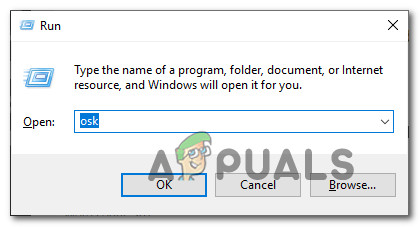Fix: Arrow Keys not Working in Excel
Several Windows users are reporting that they are unable to use the arrow keys to move between the cells in Microsoft Excel. This seems to be recurring issues that happen on a lot of different Office versions including on Excel 2010, Excel 2013 and Excel 2016. Furthermore, the issue is certainly not exclusive to a certain Windows version since is confirmed to appear on Windows 7 and Windows 10.

What is causing the arrow keys to stop working on Excel?
We investigated this particular issue by looking at various user reports and the repair strategies that are commonly being used to fix this behavior. As it turns out, there are several different potential culprits that might trigger this odd behavior:
- Scroll Lock Key is enabled – This is the most common culprit that will trigger this issue. In most cases, the key is accidentally enabled by the user via the FN keys. If this scenario is applicable, you can resolve the issue by using the On-screen keyboard to disable the Screen Lock.
- Glitched sticky keys – Another potential cause that will cause this behavior is if the Sticky keys are stuck in a limbo state. Several users that have been encountering this issue have reported that they managed to resolve it by temporarily enabling and then disabling the sticky keys.
- Corrupted Add-in or Add-in conflict – Certain add-ins or an add-in conflict can also be responsible for this behavior. If this scenario is applicable, you can resolve the issue by removing any suspicious add-in from your active fleet.
If you’re currently experiencing this issue and you’re looking for a fix that will allow you to revert back to the default behavior, this article will provide you with several troubleshooting steps. In the section below, you’ll find a collection of methods that other users in a similar situation have successfully used to fix the problem.
To remain as efficient as possible, we encourage you to follow the methods in the order that they are presented since they are ordered by efficiency and severity. Eventually, one of the fixes should resolve the issue regardless of the culprit that is causing the issue.
Method 1: Disabling Scroll Lock Key via On-Screen keyboard
If the whole worksheet is moving when you press one of the arrow keys instead of moving from cell to cell, chances are that the culprit for this behavior is the Scroll Lock Key. You probably don’t have a Scroll Lock key on your keyboard since the majority of manufacturers no longer include it on newer models, but you might have enabled it by using an FN combination.
If this scenario is applicable to your current situation, you can resolve the issue easily by using the on-screen keyboard to turn the Scroll Lock key back off. Here’s a quick guide on how to do this:
- Press Windows key + R to open up a Run dialog box. Then, type “osk” and press Enter to open up the On-Screen Keyboard.

Opening the On-Screen keyboard from a Run dialog box - Inside the On-Screen Keyboard interface, click on the ScrLk key once to deactivate it. If the key associated with Screen Lock returns to the color of the rest of keys, Screen Lock was successfully disabled.

Disabling the Screen Lock Key via the On-Screen keyboard - Open an Excel sheet and see if the issue is now resolved.
If you’re still experiencing the same behaviour, move down to the next method below.
Method 2: Cycling through the state of the Sticky keys
As multiple users have reported, this issue can also occur if the Sticky Keys feature glitches and become stuck in a limbo state. As it turns out, this ends up confusing Excel into believing that Screen Lock is enabled even when it’s not.
If you think this scenario might be applicable to your current situation, you will be able to resolve the issue by temporarily disabling the Sticky keys feature before turning off again. After doing so, the arrow key should start functioning properly.
Here’s a quick guide on how to do this:
- Press Windows key + R to open up a Run dialog box. Then, type “control” and press Enter to open up the classic Control Panel interface.
- Inside the Classic Control panel, use the search function in the top right corner to search for “ease of access“. From the results, click on Ease of Access Center.
- From this window, scroll down to Explore all settings and click on Make the keyboard easier to use.
- Scroll down to Make it easier to type and check the box associated with turn on Sticky Keys.
- Hit Apply to save the configuration, wait a couple of seconds, then uncheck the box again and click Apply once again.
- Open Excel and see if you regained the normal functionality of the arrow keys.
If the issue is still persisting, move down to the next method below.
Method 3: Disabling suspicious Add-ins
Another potential scenario in which this error will occur is a suspicious add-in that is currently active on Excel or an add-in conflict that ends up producing this issue. Several users struggling to resolve this exact problem have reported that they managed to fix it by disabling all add-ins and then systematically re-enabling them until they managed to identify the culprit.
Here’s a quick guide on how to do this:
- Open Excel and click on File from the ribbon bar at the top of the screen.
- Next, from the vertical menu, click on Options.
- Inside the Excel Options menu, click on Add-ins From the vertical menu.
- From the Add-ins menu, scroll down to the bottom of the screen and set the drop-down menu associated with Manage to Excel Add-ins before clicking on Go.
- Then, uncheck the checkbox associated with every Excel Add-in until they are all disabled and click OK.
- Repeat steps 1 to 3 to return to the Add-ins menu, scroll down to the Manage drop-down menu and set it to COM Add-ins before clicking on Go.
- Same as before, uncheck every checkbox associated with every add-in and click Ok.
- Restart Excel and see if the issue has stopped occurring.
- If the arrow keys are now functioning normally re-follow steps 1 to 6 and systematically re-enable every disabled add-in until you manage to identify which one was causing the issue. Once you do so, remove it from your list of add-ins to fix the problem.





